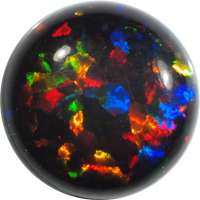Email us at goldberg@pinfire.de
Impregnated Synthetic Opals with a Play-of-Color in Red, Orange or Green and in Different Body Colors
Synthetic Opals - Black Opal, White Opal, Crystal Opal & Fire Opal
Coarse and Fine Crystalline Opals with a Non-Directional Play-of-Color
Synthetic Opal Online Shop: Synthetic Opal & Lab Created Opal
Synthetic Opals & Impregnated Synthetic Opals
Frequently asked QuestionsSome of your Questions:
These FAQs are designed to provide a better understanding of opal related terms and properties.
If you have a question that isn't answered here, please contact us at goldberg@pinfire.de.
We will be happy to help.
Q. What is a synthetic opal?
The definition of "synthetic gemstones" is clearly explained by the "World Jewellery Confederation" (Blue Books – The Gemstone Book):
4.2.3. Synthetic stones
Artificial products (5.3) having essentially the same chemical composition, physical properties and structure as that of their naturally occurring counterparts.
This means that only materials with play-of-color and composed of closed-packed silica particles with empty, partially or completely silica-filled voids can be called "synthetic opals". The water content is not a criteria. All other materials with play-of-color, but of different chemical composition are opal imitations. Terms like "lab created opal", "man-made opal", "cultured opal" and "artificial opal" are often used to describe such imitations.
Q. What is the difference between synthetic opal and synthetic impregnated opal?
The difference is that in impregnated opals the voids/space between the monodisperse silica particles are filled with a polymer and not with silica. Hence, properties like specific gravity, refractive index, hardness and temperature resistance are different compared to synthetic opals. In a strict sense "synthetic impregnated opals" are also imitation opals. But to differentiate both types of opals with silica particles embedded in a polymer from other materials with diffraction colors (other imitations with play-of-color), we describe these opals clearly and distinctive as "impregnated synthetic opal" together with a descriptive term regarding the pattern (non-direction/directional).
Q. What means "homogeneously crystallized"?
Usually synthetic and synthetic impregnated opals are prepared by sedimentation of monodisperse particles on a substrate. The nucleation of the colloidal crystal (= opal) begins on a surface. This is called heterogeneous crystallization. Compared to the heterogeneous nucleation homogeneous nucleation occurs spontaneously and randomly in the entire volume. There is no preferred growth direction, this world's first type of opal shows a non-directional polygonal pattern of play-of-color, orienting the rough opal before processing is not necessary.
Q. What is to be considered with the processing of the different types of opal?
In dependence on the chemical composition our types of opal can be processed as any other plastic material or stone. Drilling, carving, sawing, grinding and high gloss polishing with standard tools or machines are easily possible.
Q. There are other impregnated synthetic opals with a directional pattern. What makes your opals special?
Our synthetic impregnated opals with a directional pattern are translucent and not opaque, with a lower resin content of 17-18% and with a coarse-grained bright multicolored pattern of play-of-color. Furthermore, these opals can be prepared in large single pieces in weights up to 500 grams.
Q.I have read that polymers yellow over time. Does it mean that your impregnated opals change the color after a while?
No, that's not the case. We have carefully chosen the polymer to avoid yellowing. Additionally, to check changes in the visual appearance before and after prolonged exposure to UV-light we have performed tests based on the ISO ISO12870 standard and could not detect any changes (Tests for color fastness against UV radiation: ISO12870).
Q.The synthetic opals are described as "prepared after a modified Gilson process" Are the properties still the same?
Yes, of course. There is no difference in the chemical and physical properties of the new and old Gilson opals. Our synthetic opals are also composed of silica particles in a silica matrix, and can thus withstand temperatures up to 1000°C.

